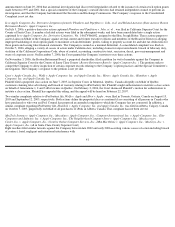Apple 2006 Annual Report Download - page 33
Download and view the complete annual report
Please find page 33 of the 2006 Apple annual report below. You can navigate through the pages in the report by either clicking on the pages listed below, or by using the keyword search tool below to find specific information within the annual report.
Further information related to the Company’s global market risks may be found in Part II, Item 7A of this Form 10-K under the subheading
“Foreign Currency Risk” and may be found in Part II, Item 8 of this Form 10-K at Notes 1 and 3 of Notes to Consolidated Financial
Statements.
The Company is subject to risks associated with environmental regulations.
Production and marketing of products in certain states and countries may subject the Company to environmental and other regulations
including, in some instances, the requirement to provide customers the ability to return product at the end of its useful life, and place
responsibility for environmentally safe disposal or recycling with the Company. Such laws and regulations have recently been passed in several
jurisdictions in which the Company operates, including various European Union member countries, Japan and certain states within the U.S.
Although the Company does not anticipate any material adverse effects in the future based on the nature of its operations and the thrust of such
laws, there is no assurance such existing laws or future laws will not have a material adverse effect on the Company’s financial condition,
liquidity, or results of operations.
Changes in accounting rules could affect the Company’s future operating results.
Financial statements are prepared in accordance with U.S. generally accepted accounting principles. These principles are subject to
interpretation by various governing bodies, including the Financial Accounting Standards Board (“FASB”) and the SEC, who create and
interpret appropriate accounting standards. A change from current accounting standards could have a significant effect on the Company’s
results of operations. In December 2004, the FASB issued new guidance that addresses the accounting for share-based payments, Statement of
Financial Accounting Standards (“SFAS”) No. 123 (revised 2004) (“SFAS No. 123R”), Share-Based Payment
, which the Company adopted in
2006. In 2006, stock-based compensation expense reduced diluted earnings per common share by approximately $0.14. Although the adoption
of SFAS No. 123R is expected to continue to have a significant impact on the Company’s results of operations, future changes to various
assumptions used to determine the fair-value of awards issued or the amount and type of equity awards granted create uncertainty as to the
amount of future stock-based compensation expense.
Changes in the Company’s tax rates could affect its future results.
The Company’s future effective tax rates could be favorably or unfavorably affected by changes in the mix of earnings in countries with
differing statutory tax rates, changes in the valuation of the Company’s deferred tax assets and liabilities, or by changes in tax laws or their
interpretation. In addition, the Company is subject to the continuous examination of its income tax returns by the Internal Revenue Service and
other tax authorities. The Company regularly assesses the likelihood of adverse outcomes resulting from these examinations to determine the
adequacy of its provision for income taxes. There can be no assurance the outcomes from these continuous examinations will not have an
adverse effect on the Company’s results of operations and financial condition.
The Company’s stock price may be volatile.
The Company’s stock has at times experienced substantial price volatility as a result of variations between its actual and anticipated financial
results and as a result of announcements by the Company and its competitors. The stock market has experienced extreme price and volume
fluctuations that have affected the market price of many technology companies in ways that may have been unrelated to the operating
performance of these companies. Furthermore, the Company believes its stock price reflects high future growth and profitability expectations.
If the Company fails to meet these expectations its stock price may significantly decline. In addition, increases in the Company’s stock price
may result in greater dilution of earnings per share.
32
























